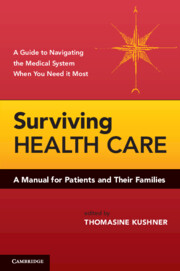Book contents
- Frontmatter
- Contents
- Contributors
- Preface
- 1 Letter to Patients
- 2 Becoming an Active Member of Your Health Care Team
- 3 Information That Will Help You with Advance Planning for Your Health Care
- 4 Responding to Medical Emergencies
- 5 What You Need to Know about Medical Errors
- 6 Being Informed When You Give Consent to Medical Care
- 7 Beware of Scorecards
- 8 Transplantation 101
- 9 When the Illness Is Psychiatric
- 10 On the Horizon
- 11 To Be or Not to Be – A Research Subject
- 12 Information That Will Help You Make Health Care Decisions for Adult Family Members
- 13 Caring for Individuals with Alzheimer's Disease
- 14 When the Patient Is a Child
- 15 Care of Elders
- 16 Being and Thinking
- 17 A Patient's Guide to Pain Management
- 18 The Hardest Decisions
- 19 What You Need to Know about Disasters
- 20 Making the Internet Work for You
- Appendix: Patient Individual Profile
- Index
18 - The Hardest Decisions
When Treatment Stops Working
Published online by Cambridge University Press: 05 June 2012
- Frontmatter
- Contents
- Contributors
- Preface
- 1 Letter to Patients
- 2 Becoming an Active Member of Your Health Care Team
- 3 Information That Will Help You with Advance Planning for Your Health Care
- 4 Responding to Medical Emergencies
- 5 What You Need to Know about Medical Errors
- 6 Being Informed When You Give Consent to Medical Care
- 7 Beware of Scorecards
- 8 Transplantation 101
- 9 When the Illness Is Psychiatric
- 10 On the Horizon
- 11 To Be or Not to Be – A Research Subject
- 12 Information That Will Help You Make Health Care Decisions for Adult Family Members
- 13 Caring for Individuals with Alzheimer's Disease
- 14 When the Patient Is a Child
- 15 Care of Elders
- 16 Being and Thinking
- 17 A Patient's Guide to Pain Management
- 18 The Hardest Decisions
- 19 What You Need to Know about Disasters
- 20 Making the Internet Work for You
- Appendix: Patient Individual Profile
- Index
Summary
Living with a potentially life-limiting illness usually brings with it a series of difficult decisions. Beyond the impact of the initial diagnosis, new and tough choices arise when:
Available treatments no longer are very effective
The disease itself worsens despite proper treatment
Complications cause a setback
Your ability to get up and around declines
You have trouble eating and drinking enough
Such events sometimes happen in rapid succession, and everyone (you, your family and friends, and medical providers) is so busy stamping out fires, nobody pauses to get the big picture. However, in general, choices about treatment need to be considered in terms of two things: prognosis and goals.
Let's look at prognosis. We've all heard stories about someone who was told he had six months to live, only to be mowing his lawn two years later, or the person who was never supposed to walk again striding across the stage to get her college diploma. Unfortunately, although these exceptions do occur, the more discouraging truth is that they are relatively rare, and most of the time, physicians overestimate rather than underestimate prognosis. The reasons for this overestimation are complex, but they are related, in part, to the fact that no doctor wants to deprive a patient or family of hope, and most patients (and their families) generally don't want to hear the reality of really bad medical news.
- Type
- Chapter
- Information
- Surviving Health CareA Manual for Patients and Their Families, pp. 264 - 278Publisher: Cambridge University PressPrint publication year: 2010

